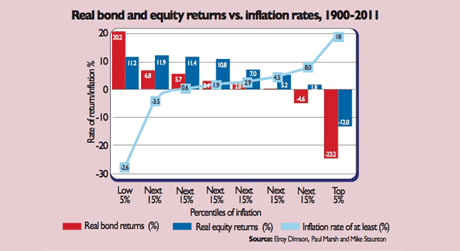Last week saw the publication of two annual studies covering the performance of a wide range of global equity markets since the beginning of the past century: the Barclays Capital Equity Gilt Study and the Credit Suisse Global Investment Returns Yearbook produced by Elroy Dimson, Paul Marsh and Mike Staunton of the London Business School (LBS). These help put the short-term turbulence in stock and bond markets in perspective and highlight strategies that boost long-term returns.
Last year gilts rose by 15.8% in inflation-adjusted terms, while UK stocks slid by 7.8%, according to Barclays Capital. Stocks have had their worst decade since the stagflationary 1970s, returning just 1.2% a year between 2001 and 2011.
Longer-term, however, they have beaten bonds. Since the end of 1899 their annual real return has been 4.9%, compared to 3.1% for gilts. Over 50 years the respective figures are 5.3% and 3.1%.
MoneyWeek
Subscribe to MoneyWeek today and get your first six magazine issues absolutely FREE

Sign up to Money Morning
Don't miss the latest investment and personal finances news, market analysis, plus money-saving tips with our free twice-daily newsletter
Don't miss the latest investment and personal finances news, market analysis, plus money-saving tips with our free twice-daily newsletter
But the longer term can be very long. The LBS data show that since 1900 the longest UK investors have had to wait to ensure a positive real return is 23 years. In the US, that figure is 17 years; in Italy, 74.
Make sure you reinvest your dividends, adds Barclays Capital: £100 invested in UK equities in 1900 would now be worth just £160 in real terms without reinvested income. With it, the sum jumps to £22,239. For £100 invested in 1945, the respective figures are £227 and £4,027. The LBS work underscores the importance of buying cheap. The stocks with the highest dividend yields have gained 10.9% a year since 1900; the lowest, 7.7%. A £1 initial investment would have grown to £107,000 with the high yielders, but just £4,000 with the low yielders.
Given the widespread concern that inflation could surge in the future due to the recent money printing by central banks, this year's LBS analysis of stocks' performance during bouts of inflation is especially interesting. Equities are widely seen as a good hedge against inflation. But they struggle when inflation rises into double figures.

The study of 112 years across 19 countries shows that on the 5% of occasions when inflation topped 18%, stocks slid by 12% on average. So if inflation returns with a vengeance, stocks offer no protection. In times of serious deflation they do well, but not as well as bonds.
The report also found that investing in the countries with the weakest currencies over the past one and five years gives equity returns (in dollar terms) a hefty fillip. This analysis covers equities in a total of 83 countries.
Since 1972, opting for the markets with the weakest currencies over the previous five years has produced a 30% annualised return. Doing this since 1900 yields a return of 16%. Something to keep in mind, perhaps, given Greece's travails, says James Mackintosh in the FT. It may not be too long before "a devalued drachma" reappears.
Get the latest financial news, insights and expert analysis from our award-winning MoneyWeek team, to help you understand what really matters when it comes to your finances.
MoneyWeek is written by a team of experienced and award-winning journalists, plus expert columnists. As well as daily digital news and features, MoneyWeek also publishes a weekly magazine, covering investing and personal finance. From share tips, pensions, gold to practical investment tips - we provide a round-up to help you make money and keep it.
-
 The shape of yields to come
The shape of yields to comeCentral banks are likely to buy up short-term bonds to keep debt costs down for governments
-
 The sad decline of investment clubs – and what comes next
The sad decline of investment clubs – and what comes nextOpinion Financial regulation and rising costs are killing off investment clubs that once used to be an enjoyable hobby, says David Prosser

